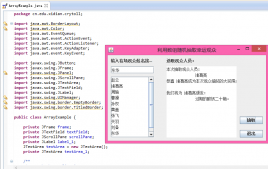一、回传协议接口和TCP方式实现:
1.接口:
|
1
2
3
4
5
6
7
8
|
import java.nio.channels.SelectionKey; import java.io.IOException; public interface EchoProtocol { void handleAccept(SelectionKey key) throws IOException; void handleRead(SelectionKey key) throws IOException; void handleWrite(SelectionKey key) throws IOException; } |
2.实现:
|
1
2
3
4
5
6
7
8
9
10
11
12
13
14
15
16
17
18
19
20
21
22
23
24
25
26
27
28
29
30
31
32
33
34
35
36
37
38
39
40
41
42
43
44
45
46
47
48
49
50
|
import java.nio.channels.*; import java.nio.ByteBuffer; import java.io.IOException; public class TCPEchoSelectorProtocol implements EchoProtocol{ private int bufSize; // Size of I/O buffer public EchoSelectorProtocol(int bufSize) { this.bufSize = bufSize; } public void handleAccept(SelectionKey key) throws IOException { SocketChannel clntChan = ((ServerSocketChannel) key.channel()).accept(); clntChan.configureBlocking(false); // Must be nonblocking to register // Register the selector with new channel for read and attach byte buffer clntChan.register(key.selector(), SelectionKey.OP_READ, ByteBuffer.allocate(bufSize)); } public void handleRead(SelectionKey key) throws IOException { // Client socket channel has pending data SocketChannel clntChan = (SocketChannel) key.channel(); ByteBuffer buf = (ByteBuffer) key.attachment(); long bytesRead = clntChan.read(buf); if (bytesRead == -1) { // Did the other end close? clntChan.close(); } else if (bytesRead > 0) { // Indicate via key that reading/writing are both of interest now. key.interestOps(SelectionKey.OP_READ | SelectionKey.OP_WRITE); } } public void handleWrite(SelectionKey key) throws IOException { /* * Channel is available for writing, and key is valid (i.e., client channel * not closed). */ // Retrieve data read earlier ByteBuffer buf = (ByteBuffer) key.attachment(); buf.flip(); // Prepare buffer for writing SocketChannel clntChan = (SocketChannel) key.channel(); clntChan.write(buf); if (!buf.hasRemaining()) { // Buffer completely written? //Nothing left, so no longer interested in writes key.interestOps(SelectionKey.OP_READ); } buf.compact(); // Make room for more data to be read in } } |
二、NIO TCP客户端:
|
1
2
3
4
5
6
7
8
9
10
11
12
13
14
15
16
17
18
19
20
21
22
23
24
25
26
27
28
29
30
31
32
33
34
35
36
37
38
39
40
41
42
43
44
|
import java.net.InetSocketAddress; import java.net.SocketException; import java.nio.ByteBuffer; import java.nio.channels.SocketChannel; public class TCPEchoClientNonblocking { public static void main(String args[]) throws Exception { String server = "127.0.0.1"; // Server name or IP address // Convert input String to bytes using the default charset byte[] argument = "0123456789abcdefghijklmnopqrstuvwxyz".getBytes(); int servPort = 5500; // Create channel and set to nonblocking SocketChannel clntChan = SocketChannel.open(); clntChan.configureBlocking(false); // Initiate connection to server and repeatedly poll until complete if (!clntChan.connect(new InetSocketAddress(server, servPort))) { while (!clntChan.finishConnect()) { System.out.print("."); // Do something else } } ByteBuffer writeBuf = ByteBuffer.wrap(argument); ByteBuffer readBuf = ByteBuffer.allocate(argument.length); int totalBytesRcvd = 0; // Total bytes received so far int bytesRcvd; // Bytes received in last read while (totalBytesRcvd < argument.length) { if (writeBuf.hasRemaining()) { clntChan.write(writeBuf); } if ((bytesRcvd = clntChan.read(readBuf)) == -1) { throw new SocketException("Connection closed prematurely"); } totalBytesRcvd += bytesRcvd; System.out.print("."); // Do something else } System.out.println("Received: " + // convert to String per default charset new String(readBuf.array(), 0, totalBytesRcvd).length()); clntChan.close(); } } |
三、NIO TCP服务端:
|
1
2
3
4
5
6
7
8
9
10
11
12
13
14
15
16
17
18
19
20
21
22
23
24
25
26
27
28
29
30
31
32
33
34
35
36
37
38
39
40
41
42
43
44
45
46
47
48
49
50
51
52
53
54
55
56
57
58
59
|
import java.io.IOException; import java.net.InetSocketAddress; import java.nio.channels.*; import java.util.Iterator; public class TCPServerSelector { private static final int BUFSIZE = 256; // Buffer size (bytes) private static final int TIMEOUT = 3000; // Wait timeout (milliseconds) public static void main(String[] args) throws IOException { int[] ports = {5500}; // Create a selector to multiplex listening sockets and connections Selector selector = Selector.open(); // Create listening socket channel for each port and register selector for (int port : ports) { ServerSocketChannel listnChannel = ServerSocketChannel.open(); listnChannel.socket().bind(new InetSocketAddress(port)); listnChannel.configureBlocking(false); // must be nonblocking to register // Register selector with channel. The returned key is ignored listnChannel.register(selector, SelectionKey.OP_ACCEPT); } // Create a handler that will implement the protocol TCPProtocol protocol = new TCPEchoSelectorProtocol(BUFSIZE); while (true) { // Run forever, processing available I/O operations // Wait for some channel to be ready (or timeout) if (selector.select(TIMEOUT) == 0) { // returns # of ready chans System.out.print("."); continue; } // Get iterator on set of keys with I/O to process Iterator<SelectionKey> keyIter = selector.selectedKeys().iterator(); while (keyIter.hasNext()) { SelectionKey key = keyIter.next(); // Key is bit mask // Server socket channel has pending connection requests? if (key.isAcceptable()) { System.out.println("----accept-----"); protocol.handleAccept(key); } // Client socket channel has pending data? if (key.isReadable()) { System.out.println("----read-----"); protocol.handleRead(key); } // Client socket channel is available for writing and // key is valid (i.e., channel not closed)? if (key.isValid() && key.isWritable()) { System.out.println("----write-----"); protocol.handleWrite(key); } keyIter.remove(); // remove from set of selected keys } } } } |
以上就是本文的全部内容,查看更多Java的语法,也希望大家多多支持服务器之家。













